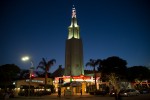Picture this: You’re walking through Westwood on a nice, sunny Saturday afternoon. You wander onto Broxton Avenue, seeing an array of storefronts and people. You decide to treat yourself to a warm, cinnamon-sugar cookie from Diddy Riese, and you step outside, eager to enjoy its sugary sweetness while feeling one with the community. You look around, though, and the only available community space you see is three dusty plastic chairs.
For years, Westwood’s lack of character could be explained by its skewed decisionmaking team, the Westwood Neighborhood Council. Despite students composing a large portion of the population, the WWNC gave student representatives little chance to participate in elections or meetings.
But now, with the student-centric North Westwood Neighborhood Council on the scene, the time has never been better for Westwood to build a community. And that starts by building community spaces.
The Westwood Village Improvement Association has heard proposals for open spaces that suggested creating rows of tables and chairs on Broxton Avenue for passersby to enjoy themselves. The first proposal came in 2012 and focused on the southern end of Broxton, but later was modified in 2015 to convert the northern end. However, per Andrew Thomas, WVIA executive director, the plan was paused for examination and bogged down by concerns about programming.
Creating a place where people simply can hang out gives character to a community and makes it far more enjoyable for its members. Westwood is lacking in reasons for residents to venture into the Village, besides day-to-day errands, and lacks an obvious destination where people can meet. For the Village to thrive, the community needs space – not just storefronts and restaurants.
Westwood is home to one of the largest universities by enrollment in the country, yet fails to cater to students. Instead, it’s a drive-through town that primarily serves homeowners and car owners – things the average UCLA student is not.
Olivia Duff, a first-year world arts and culture student, said she’s never really thought of Westwood as a place to hang out. She said Westwood pales in comparison to her hometown of Berkeley, California.
“When I think about Berkeley and other college towns, I realize that Westwood is one of the few places that (doesn’t) have a common place for people to sit and eat or just (hang out),” Duff said. “I often find myself going to Westwood for what I need and then leaving right after.”
Thomas said the WVIA is considering ideas for a pedestrian space, though it hasn’t moved forward with any specific plans.
“Right now, we’re open to what kind of plaza it will be, but we’re focusing on lower Broxton,” Thomas said. “Having a destination is huge, and right now Westwood doesn’t have a place where people can gather.”
By not giving residents a place to sit and enjoy the area, Westwood really only exists as a domain of businesses. This strips it of the ability to be a connected community.
Compare this to other neighborhoods in the city, such as Santa Monica, where residents can enjoy themselves on the Third Street Promenade, or even Downtown, where visitors can take a break from the busyness of the city by resting on benches outside the Los Angeles County Museum of Art. Meanwhile, Westwood residents are forced to make do with bus stops and a couple broken benches.
But Westwood has potential venues that easily can be turned into community spaces. The Broxton area, for example, already offers a weekly farmers’ market and occasional events – including the fall quarter Westwood Block Party – so it already has its foot in the door as a destination. With a permanent pedestrian plaza, Westwood could host live performances, movie screenings and community events. This would allow residents to congregate and connect, while also supporting local art and culture.
Michael Skiles, president of the Graduate Students Association and the NWWNC, has long supported a pedestrian plaza along Broxton and thinks it could be home to events like farmers’ markets, WestWoodstock and performances, fitted with tables and chairs so people have somewhere to sit and enjoy.
Skiles also hopes for a parklet on Glendon Avenue near Ministry of Coffee, and for restaurants to start creating outdoor spaces that foster appreciation for the area.
“Right now, the nearest parks are pretty far from campus, but now we’re hoping to create parklike spaces by reclaiming areas that really aren’t needed for cars anymore,” Skiles said.
For college students especially, many of whom live in shoebox-sized dorm rooms, a community space would give them an enjoyable hangout spot while helping to connect the town and the campus.
Certainly, creating open spaces raises questions of whether they will disrupt the surrounding area. However, these proposed areas are naturally closed off and lend themselves to being public spaces. For instance, Broxton already is a one-way street without very much traffic, so its elimination as a through street for cars wouldn’t disrupt the community. Further, open space areas are such a significant addition to Westwood that any temporary and trivial concerns should not outweigh or delay their implementations.
Pedestrian spaces are both beneficial and feasible. They add value to the community, encourage visitors and residents to patronize businesses and gin up interest in taking part in the Village.
At the very least, they give you a place to eat your Diddy Riese cookies in peace.

The students are only guests in Westwood some of us actually live there!